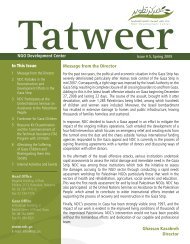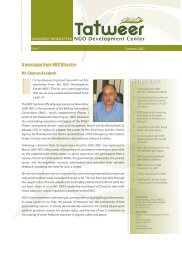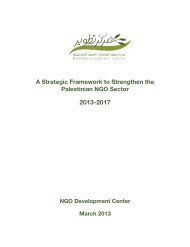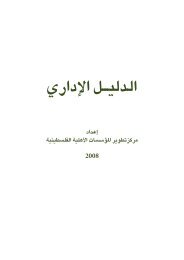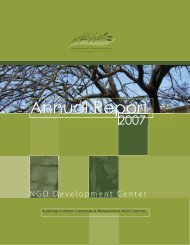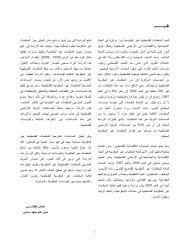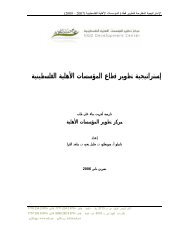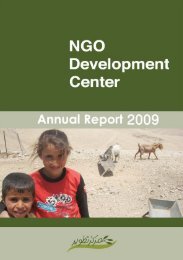Tracking External Donor Funding.pdf - NDC
Tracking External Donor Funding.pdf - NDC
Tracking External Donor Funding.pdf - NDC
Create successful ePaper yourself
Turn your PDF publications into a flip-book with our unique Google optimized e-Paper software.
When asked whether international aid contributes to social justice, only 32% responded positively, while the<br />
remainder chose no.<br />
MAS 2009 <strong>Donor</strong> Straw Poll<br />
In order to supplement our quantitative survey, MAS approached donors with a follow-up straw poll. These brief<br />
surveys were given anonymously to international aid agency employees who were asked to respond according to their<br />
opinions, as opposed to the position of their organization. It should be noted that this survey was not of adequate size,<br />
30 people, to be taken as more than indicative. It should also be noted that we expect many of the responses to have<br />
been affected by the recent war on the Gaza Strip, especially the question asking about the need for aid based on<br />
geography.<br />
The table below shows aid workers’ perceptions of the sectors most in need of international funding in the final opinion<br />
column. The columns 2006 – 2008 represent the actual disbursements of international aid by sector as captured in our<br />
survey.<br />
Table 2: International <strong>Donor</strong> Worker Perceptions<br />
versus Organizational Trends by Sector<br />
Sector 2006 2007 2008 Opinion<br />
Children’s Activities 2.31% 2.74% 3.73% 1.4%<br />
Charity & Relief 5.21% 4.04% 8.88% 2.9%<br />
Elderly Care 0.22% 1%<br />
Family Planning 0.53% 0.08% 1.70% 1.9%<br />
Liberal Arts Education 5.40% 6.22% 8.25% 1.9%<br />
Rural Development 10.93% 15.88% 10.17% 14.8%<br />
Water and Environment 5.47% 2.38% 3.51% 15.2%<br />
Health Services 18.74% 15.45% 14.72% 5.7%<br />
Research 2.05% 1.26% 3.00% 1%<br />
Disabled Care 5.05% 4.68% 3.83% 1%<br />
Vocational Training 2.85% 2.04% 3.06% 4.8%<br />
Religious Activities 0.03%<br />
Scientific Education 1.87% 4.28% 2.61% 4.8%<br />
Women’s Affairs 7.29% 8.97% 7.99% 10%<br />
Human Rights 10.21% 10.83% 10.60% 15.7%<br />
Enhancing Democracy 6.65% 4.81% 3.58% 3.8%<br />
Good Governance 8.73% 9.32% 7.84% 14.1%<br />
Youth and Sports 2.66% 1.64% 1.54% 1.9%<br />
Other 4.04% 5.35% 4.78%<br />
Total 100% 100% 100% 100%<br />
Note: Of the 30 international aid workers given the survey, 29 returned<br />
completed questionnaires.<br />
Empty Cells are equal to 0% and numbers for the opinions are rounded to the<br />
nearest tenth of a percent.<br />
The most dramatic differences between international agency worker perceptions and the reality on the ground are in the<br />
sectors of Charity and Relief, Water, Health, Liberal Arts Education, Human Rights and Good Governance. If worker<br />
perceptions were to become reality in 2009, Charity and relief would decrease by nearly 2/3, as would funds to the<br />
Health Sector. Water would nearly quintuple its funding while Human rights would increase by a third. Other sectors<br />
that international workers would emphasize more than their organizations were: Youth, Governance, Democracy,<br />
Women, Scientific Education, Rural Development, Vocational Training and Elderly Care. Other sectors that these<br />
workers would de-emphasize were: Children’s Activities, Liberal Arts, Research and Disabled Care.<br />
5<br />
For more analysis on this subject, see: Brynen 1995; Hanafi and Tabar 2004, 2005; Said 2005; and Taylor 1997.<br />
84


